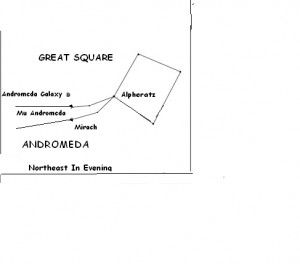
If you look due east around 9 pm., you may see a large square pattern of stars. This group of secondary and third magnitude stars are not particularly conspicuous in themselves, but are made so by the almost total lack of even moderately bright stars within the “square” they define.
This square star pattern or asterism has its own name. It’s called the Great Square of Pegasus, and it’s one of the outstanding sky marks of late summer and fall. This pattern lies at the center of the constellation Pegasus supposedly marking the wings of that mythical flying horse. The Great Square of Pegasus looming up in the east is an early foreshadowing of fall.
Like most celestial figures, the Square falls somewhat short of its name. It is not quite

a square, and furthermore, it stands at this season on one corner, giving it the appearance of a squat kite or a baseball diamond. The Square is a bit bigger than your fist at arm’s length. By the end of September it’s high enough in the sky to be visible as soon as it gets dark.
The Square of Pegasus is a great jumping off point for finding the famous Andromeda Galaxy, also known as M31. The Andromeda Galaxy is the nearest large spiral galaxy to our Milky Way. It’s over one million light-years away, teeming with hundreds of billions of stars and it’s the most distant object visible to the unaided eye.
The constellation Andromeda can be seen as two graceful streams of stars extending from the left side of the Square, beginning at the star Alpheratz. You can learn to find to find the Andromeda galaxy by “star-hopping” from the Great Square to the two stars marked here – first Mirach, then Mu Andromedae. An imaginary line drawn through these two stars points to the Andromeda galaxy. The Andromeda galaxy appears to the eye as a fuzzy and faint patch of light about the size of the full Moon.
Dazzling Jupiter is up nicely by nightfall and shines brightly in the southern sky all autumn. Its four moons and weather bands can be easily seen in a small telescope. The brilliant “morning star” blazing away due east in the dawn sky is the planet Venus.
Clear skies!



